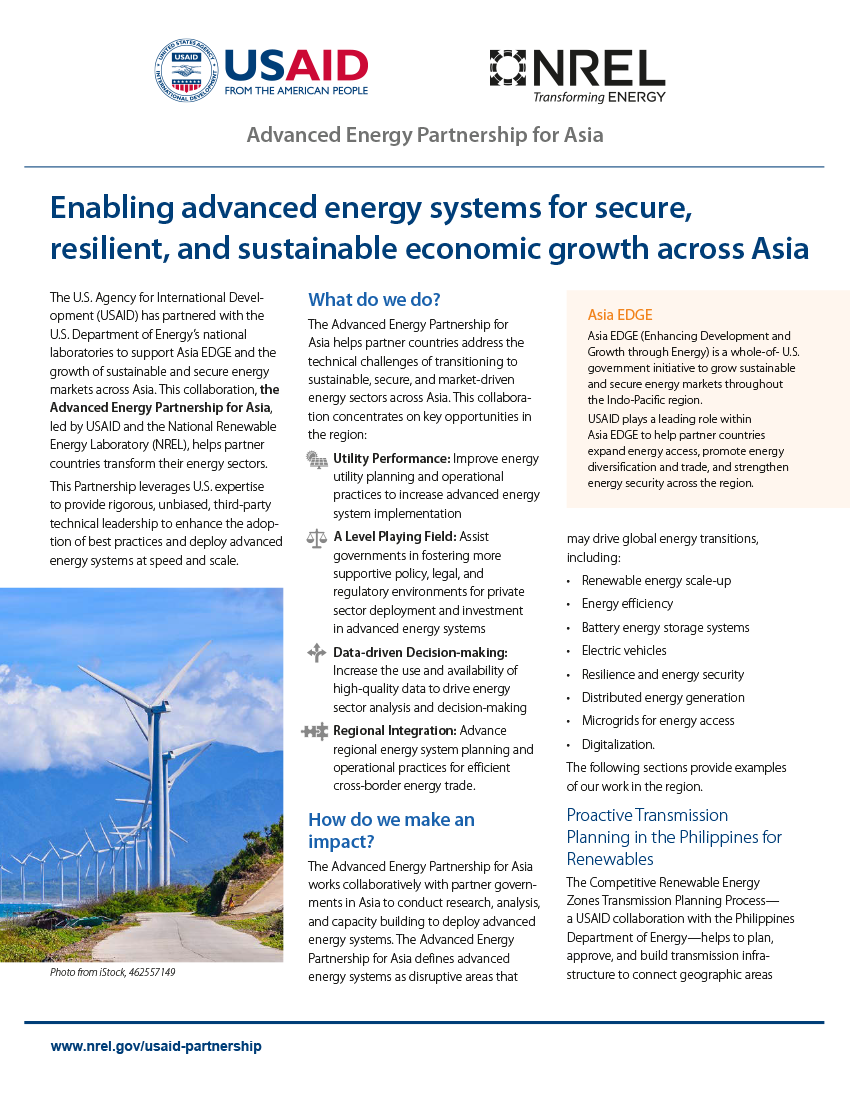Speeches Shim
The U.S. Agency for International Development (USAID) has partnered with the U.S. Department of Energy’s national laboratories to support Asia EDGE and the growth of sustainable and secure energy markets across Asia. This collaboration, the Advanced Energy Partnership for Asia, led by USAID and the National Renewable Energy Laboratory (NREL), helps partner countries transform their energy sectors. This Partnership leverages U.S. expertise to provide rigorous, unbiased, third-party technical leadership to enhance the adoption of best practices and deploy advanced energy systems at speed and scale.
What do we do?
Advanced Energy Partnership for Asia ![]() (pdf - 586k)
(pdf - 586k)
The Advanced Energy Partnership for Asia helps partner countries address the technical challenges of transitioning to sustainable, secure, and market-driven energy sectors across Asia. This collaboration concentrates on key opportunities in the region: Utility Performance: Improve energy utility planning and operational practices to increase advanced energy system implementation
- A Level Playing Field: Assist governments in fostering more supportive policy, legal, and regulatory environments for private sector deployment and investment in advanced energy systems
- Data-driven Decision-making: Increase the use and availability of high-quality data to drive energy sector analysis and decision-making
- Regional Integration: Advance regional energy system planning and operational practices for efficient cross-border energy trade.
How do we make an impact?
The Advanced Energy Partnership for Asia works collaboratively with partner governments in Asia to conduct research, analysis, and capacity building to deploy advanced energy systems. The Advanced Energy Partnership for Asia defines advanced energy systems as disruptive areas that may drive global energy transitions, including:
- Renewable energy scale-up
- Energy efficiency
- Battery energy storage systems
- Electric vehicles
- Resilience and energy security
- Distributed energy generation
- Microgrids for energy access
- Digitalization.
The following sections provide examples of our work in the region.
Proactive Transmission Planning in the Philippines for Renewables
The Competitive Renewable Energy Zones Transmission Planning Process— a USAID collaboration with the Philippines Department of Energy—helps to plan, approve, and build transmission infrastructure to connect geographic areas with high-quality renewable energy resources and private sector interest to the power system. The process supports the reliable and economic integration of renewable energy—helping the country to reach ambitious clean energy targets.
Floating Solar Photovoltaics in Southeast Asia
Floating Solar Photovoltaics in Southeast Asia Floating solar photovoltaics is an emerging application in which solar photovoltaic systems are sited directly on water bodies. This regional project aims to identify best practices that enable the deployment of floating solar in Southeast Asia and characterize how this emerging technology could potentially complement existing hydropower generation in the region.
ASEAN Interconnection Masterplan Study III (AIMS III)
The Association of Southeast Asian Nations (ASEAN) Centre for Energy is leading a regional effort to update AIMS III to guide discussions of multilateral power trade in the region. This study explores options to efficiently and reliably meet the regional goal of 23% renewable energy by 2025. The Advanced Energy Partnership for Asia will draw on NREL’s extensive power system modeling and planning experience to provide expert advisory support to AIMS III.
Southeast Asia Renewable Energy Data Explorer — Powered by the Advanced Energy Partnership for Asia
High-quality, robust, and reliable renewable energy resource data are essential for both private sector investment and the development of enabling energy sector policies. Access to—and use of—high-quality data greatly reduces uncertainty for clean energy decision-making, improves the bankability of renewable energy projects, and results in lower project costs. Currently, there is a significant gap in access to comprehensive renewable energy resource data in Southeast Asia. The Southeast Asia Renewable Energy Data Explorer will support the collection, development, and open dissemination of this critical data and allow for visualization and analysis to inform key decisions. Highquality data that has high temporal and spatial resolution will allow countries to compare clean energy options with conventional choices—leveling the playing field for renewable energy and ensuring that decision-makers can identify the leastcost option that achieves their goals. Learn more at: www.re-explorer.org


Comment
Make a general inquiry or suggest an improvement.